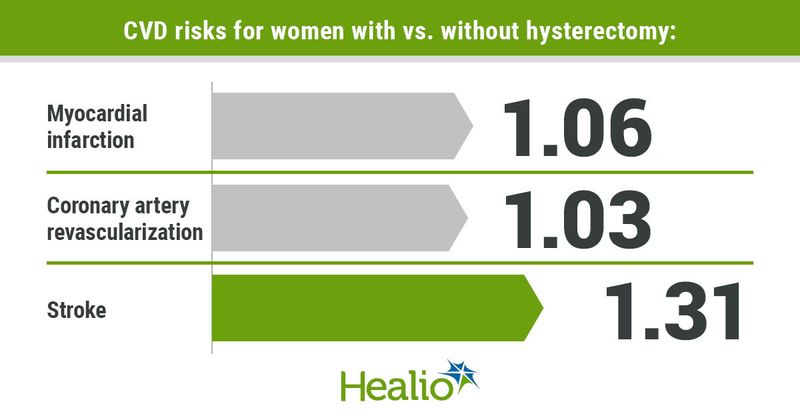Hysterectomy in women younger than 50 years linked to increased CVD risk
Click Here to Manage Email Alerts
Key takeaways:
- CVD incidence was higher for women who had a hysterectomy vs. women who did not.
- Risk for stroke was significantly higher for women who had a hysterectomy vs. women who did not.
Women in Korea who underwent hysterectomy before age 50 years had an increased risk for CVD, specifically stroke, researchers reported in JAMA Network Open.
“Examining the use of hysterectomy at a younger age and women’s risk of CVD is important since it is a commonly performed gynecologic procedure with well-documented benefits in relieving symptoms and improving quality of life,” Jin-Sung Yuk, MD, PhD, from the department of obstetrics and gynecology at Sanggye Paik Hospital at the Inje University College of Medicine in Seoul, South Korea, and colleagues wrote.

Yuk and colleagues conducted a Korean population-based cohort study of 135,575 women (median age, 45 years) aged 40 to 49 years from 2011 to 2014. Researchers matched these women into hysterectomy (n = 55,539) and non-hysterectomy (n = 55,539) groups in age, socioeconomic status, region, Charlson Comorbidity Index, hypertension, diabetes, dyslipidemia, menopause, menopausal hormone therapy and adnexal surgery.
The primary outcome was composite incidental CVD, including myocardial infarction, coronary artery revascularization and stroke, and the individual events.
During a median follow-up period of 7.9 years, CVD incidence was 115 per 100,000 person-years in the hysterectomy group compared with 96 per 100,000 person-years in the non-hysterectomy group. When adjusting for confounding factors, the hysterectomy group had a 25% higher CVD risk compared with the non-hysterectomy group (adjusted HR = 1.25; 95% CI, 1.09-1.44; P = .002).
In addition, researchers noted comparable incidences of myocardial infarction (aHR = 1.06; 95% CI, 0.56-2.02; P = .86) and coronary artery revascularization (aHR = 1.03; 95% CI, 0.74-1.43; P = .85) among both groups. However, stroke risk was higher in the hysterectomy group compared with the non-hysterectomy group (aHR = 1.31; 95% CI, 1.12-1.53; P < .001).
The hysterectomy group had higher CVD risk even when women who underwent oophorectomy were excluded (HR = 1.24; 95% CI, 1.06-1.44).
“Although we found that widely performed hysterectomy with a broad indication for benign diseases at premenopausal ages slightly increases the risk of CVD, the incidence is not high, so a change in clinical practice may not be needed,” the researchers wrote.
